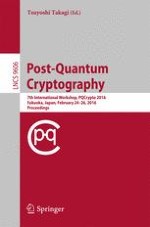2016 | Buch
Post-Quantum Cryptography
7th International Workshop, PQCrypto 2016, Fukuoka, Japan, February 24-26, 2016, Proceedings
herausgegeben von: Tsuyoshi Takagi
Verlag: Springer International Publishing
Buchreihe : Lecture Notes in Computer Science
